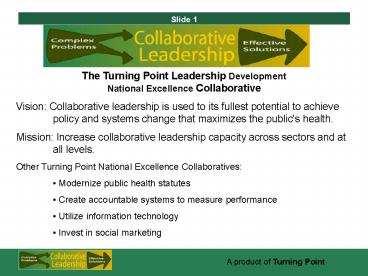Creating Clarity - PowerPoint PPT Presentation
1 / 17
Title:
Creating Clarity
Description:
Vision: Collaborative leadership is used to its fullest potential to achieve ... Source: Ayre, Clough, and Norris, Facilitating Community Change, 2000. Slide 14 ... – PowerPoint PPT presentation
Number of Views:57
Avg rating:3.0/5.0
Title: Creating Clarity
1
The Turning Point Leadership Development
National Excellence Collaborative Vision
Collaborative leadership is used to its fullest
potential to achieve policy and systems change
that maximizes the public's health. Mission
Increase collaborative leadership capacity across
sectors and at all levels. Other Turning Point
National Excellence Collaboratives Modernize
public health statutes Create accountable
systems to measure performance Utilize
information technology Invest in social
marketing
2
What is Collaborative Leadership?
- The processes, activities, and relationships in
which a group and its members engage in
collaboration. - Collaboration is defined as exchanging
information and sharing or pooling resources for
mutual benefit to achieve a common purpose.
3
What is a Collaborative Leader?
- Someone who safeguards and promotes the
collaborative process.
4
Who is a Collaborative Leader?
5
Why is Collaborative Leadership Important?
- Most public health problems are complex,
interdependent, and messy. - These type of problems require a systems approach
with diverse input and multiple perspectives. - Many sectors need to own the solution for it to
be successfully implemented.
6
Six Practices of Collaborative Leadership
7
Six Practices of Collaborative Leadership
- Identified by the Turning Point Leadership
Development National Excellence Collaborative - Research included
- Literature reviews
- Individual interviews
- Focus groups
- Expert panel debates
- Attendance at leadership development training
programs
8
Six Practices of Collaborative Leadership
SP
DP
BT
CC
SR
Complex Problem
Effective Solution
AE
9
Creating Clarity
10
Creating Clarity
- Definition - Being clear about the goals,
direction, and envisioned future of a community
for a particular issue. - Outcome - Committing to a cause that transcends
the self recognizing ethical or moral standards
that provide guidance. - How - Integrating personal vision into a shared
vision by finding common ground. - Means - Mobilizing people through a shared vision
and positive action and sustaining the vision in
difficult times.
11
Locus of Vision
- Traditional Leadership
- Solitary, charismatic leader provides inspiring
vision - Persuades others to align in support of vision
- Motivates others to achieve the vision
- Collaborative Leadership
- Shared vision leads to mutual understanding and
commitment. - Collaborative leaders
- Provide inspiration
- Provide means for creating a shared vision
- Help stakeholders set the direction and move in
that direction
12
What is a Stakeholder?
- Any person, organization or entity that has a
stake (vested interest) in determining the
future of an issue or who is affected by the
issue.
13
Working Agreements
- Decision Making
- Disagreement/Conflict
- Power/Influence
- Interaction/Support
- Communications
- Problem Solving
- Time/Attendance
- Expectations About Productivity
- Source Ayre, Clough, and Norris, Facilitating
Community Change, 2000.
14
Shared Visioning Process
- Develop personal vision of project.
- Share visions in triads, refine and list common
themes. - Record common values/themes among visions and
post. - Group common themes, name groupings, check for
alignment. - Write vision statement.
- Adapted from Chrislip. Collaborative Leadership
Fieldbook, p. 109-110.
15
What Visions Are Not
- A mission statement Why do we exist now?
- A strategic plan How do we plan to get there?
- A set of objectives We will accomplish X by Y
time to Z target audience.
16
Creating Clarity Framework
Current Reality
Desired Future
Mobilization
Identify key issues Develop Action Teams Develop
Action Plans Implement Plans Evaluate
Shared vision Common values
Environmental assessment
17
Methods for Change
- Exposure to different ideas
- Exposure to different cultures
- Experience/Practice
- Self-reflection (e.g., logs, journals)
- Mentoring/Coaching
- 360 Assessment, shadowing
- Peer support































